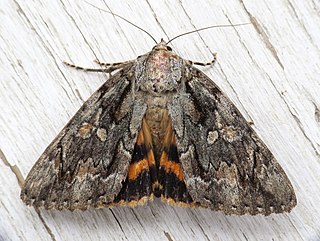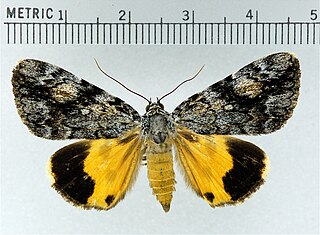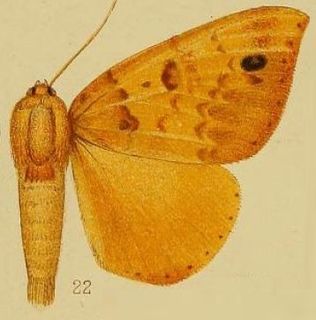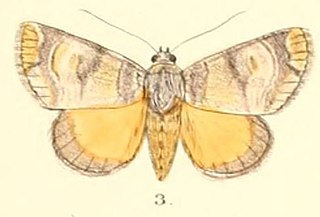
Oenosandridae is a family of noctuoid moths in the order Lepidoptera. The members are moths found in Australia. Genera include Diceratucha, Discophlebia, Nycteropa, and Oenosandra.

Discophlebia catocalina, the yellow-tailed stub moth, is a moth of the family Oenosandridae first described by Rudolf Felder in 1874. It is found in the south-east quarter of Australia.

Termessa is a genus of moths in the subfamily Arctiinae The genus was described by Newman in 1856.

Zalissa is a genus of moths of the family Noctuidae. The genus was erected by Francis Walker in 1865.

Heliophisma is a genus of moths of the family Noctuidae.
Catocala cara, the darling underwing, is an moth of the family Erebidae. The species was first described by Achille Guenée in 1852. It can be found in the United States east of the Rocky Mountains; it occurs west at least to Oklahoma and north at least to Illinois. It also ranges into southern Canada, but only barely so.

Catocala piatrix, the penitent underwing, is a moth from North America. The species was first described by Augustus Radcliffe Grote in 1864. It is placed in subfamily Catocalinae, either of the family Noctuidae, or – if the Noctuidae are circumscribed more strictly – of family Erebidae. Within the Catocalinae, it belongs to tribe Catocalini and – if the Noctuidae are circumscribed widely – subtribe Catocalina.

Catocala neogama, the bride, is an moth in the family Erebidae first described by James Edward Smith in 1797. It is found in North America east of the Rocky Mountains, from Maine and Quebec south to northern Florida and west to South Dakota, New Mexico, and into Arizona and Texas. Its westernmost population from the semiarid Colorado Plateau region is rather distinct and was once considered a separate species, but is now regarded as a well-marked subspecies C. n. euphemia.

Catocala amica, the girlfriend underwing, is a moth of the family Erebidae. The species was first described by Jacob Hübner in 1818. It is found from southern Canada through the United States east of the Rocky Mountains, ranging westward to Oklahoma and Arizona, northward to Minnesota and southwestward to Texas.

Catocala junctura, the joined underwing or Stretch's underwing, is an moth in the family Erebidae. The species was first described by Francis Walker in 1858. It is found throughout temperate North America ranging from New York and Pennsylvania west to Montana, Colorado, Oklahoma, Arizona and into Texas, and north to southern Illinois, extreme southern Alberta and Saskatchewan; it has also been recorded west of the Rocky Mountains from California and south-eastern British Columbia. It is typically found near water, where the food plants of its caterpillar larvae grow plentifully.

Catocala delilah, the Delilah underwing, is a moth in the family Erebidae. The species was first described by Strecker in 1874. It is found in the southern and midwestern United States, from Ohio south to Florida and west to Texas and Oklahoma.

Heliophisma klugii is a species of moth of the family Noctuidae first described by Jean Baptiste Boisduval in 1833. It is found in Africa, including West Africa, Madagascar, Sierra Leone and South Africa.

Heliophisma xanthoptera is a species of moth of the family Erebidae first described by George Hampson in 1910. It is found in Kenya, Mozambique, Tanzania Sierra Leone, South Africa and Zambia.

Trisuloides is a genus of moths of the family Noctuidae.

Zalissa catocalina is a moth of the family Noctuidae first described by Francis Walker in 1865. It is found in Papua New Guinea and Australia. In Australia, it is found in or near rainforests in eastern Australia as far south as northern New South Wales.

Antitrisuloides is a genus of moths of the family Noctuidae.

Antitrisuloides catocalina is a moth of the family Noctuidae first described by Frederic Moore in 1882. It is found in India.
Termessa catocalina is a moth in the subfamily Arctiinae. It was described by Francis Walker in 1865. It is found in Australia, where it has been recorded from New South Wales and Victoria.












